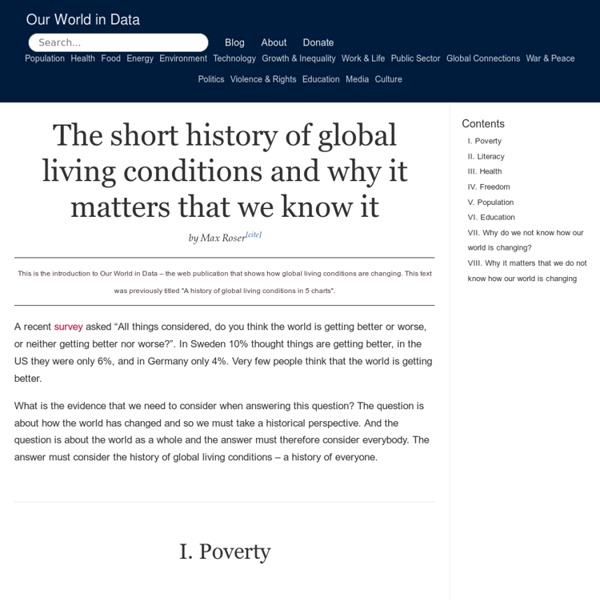A history of global living conditions in 5 charts - Our World In Data

https://ourworldindata.org/a-history-of-global-living-conditions-in-5-charts
Related: Mappe storiche
• Economics
40 maps that explain the Roman Empire
by Timothy B. Lee on August 19, 2014 Two thousand years ago, on August 19, 14 AD, Caesar Augustus died. He was Rome's first emperor, having won a civil war more than 40 years earlier that transformed the dysfunctional Roman Republic into an empire. Under Augustus and his successors, the empire experienced 200 years of relative peace and prosperity.
The Mismeasure of Inequality
In october 2011, the Congressional Budget Office published a report, “Trends in the Distribution of Household Income between 1979 and 2007,” showing that, during the period studied, aggregate income (as defined by the cbo) in the highest income quintiles grew more rapidly than income in the lower quintiles. This was particularly true for the top one percent of earners. This cbo study has been cited by the media and politicians as confirmation that income inequality has increased “substantially” during the period studied, and has been used to support President Obama’s claim that income inequality is a serious and growing problem in the United States that must be addressed by raising taxes on the highest income earners.
7 maps that will change how you see the world
A Japanese architect has won a prestigious award for creating a new map, because it shows the world as it really is. The AuthaGraph World Map angles continents in order to show their true distance from one another. Hajime Narukawa won the Good Design Award, beating over 1,000 entries in a variety of categories. “The AuthaGraph World Map provides an advanced precise perspective of our planet,” explain the organizers of the award. Not only that, but the map can then be transformed into a globe. Why is this news?
China's Hong Kong-Zhuhai-Macao mega bridge is more than an engineering challenge
By China correspondent Bill Birtles in Zhuhai, Guangdong province Updated China is about to open the world's longest sea bridge to traffic in the latest demonstration of its infrastructure ambitions. The 55-kilometre bridge and tunnel project links the two special administrative regions of Hong Kong and Macau with the mainland, slashing travel time and linking up to 60 million people into a metropolis-style economy. When the first cars begin crossing mid-year, it will mark the end of an eight-year construction period that has been hampered by delays, cost blowouts and even worker deaths. The engineering challenges have been immense.
Historical maps
home page Down to: 6th to 15th Centuries | 16th and 19th Centuries | 1901 to World War Two | 1946 to 21st Century The Ancient World ... index of places Aegean Region, to 300 BCE Aegean Region, 185 BCE Africa, 2500 to 1500 BCE
Market Share Definition
What is 'Market Share' Market share represents the percentage of an industry or market's total sales that is earned by a particular company over a specified time period. Market share is calculated by taking the company's sales over the period and dividing it by the total sales of the industry over the same period.
30 Breathtaking Satellite Photos That Will Change How You See Our World
Daily Overview is a new project that shares one satellite photo from Digital Globes a day in an attempt to change the way we see our planet Earth. Show Full Text The project was inspired by the Overview Effect experience, which is a cognitive shift of perspective and worldview experienced by the astronauts when they get to see the planet Earth from space for the first time.
Women Lose Out to Men Even Before They Graduate From College
For almost 40 years, women have outnumbered men on U.S. college campuses. They’re accepted to the same schools as men, study in the same degree programs and graduate at higher rates than men. So when female graduates enter the labor force, you’d expect that they would at least find the same opportunities as their male peers, if not better ones. That hasn’t necessarily happened, though.
Related:



